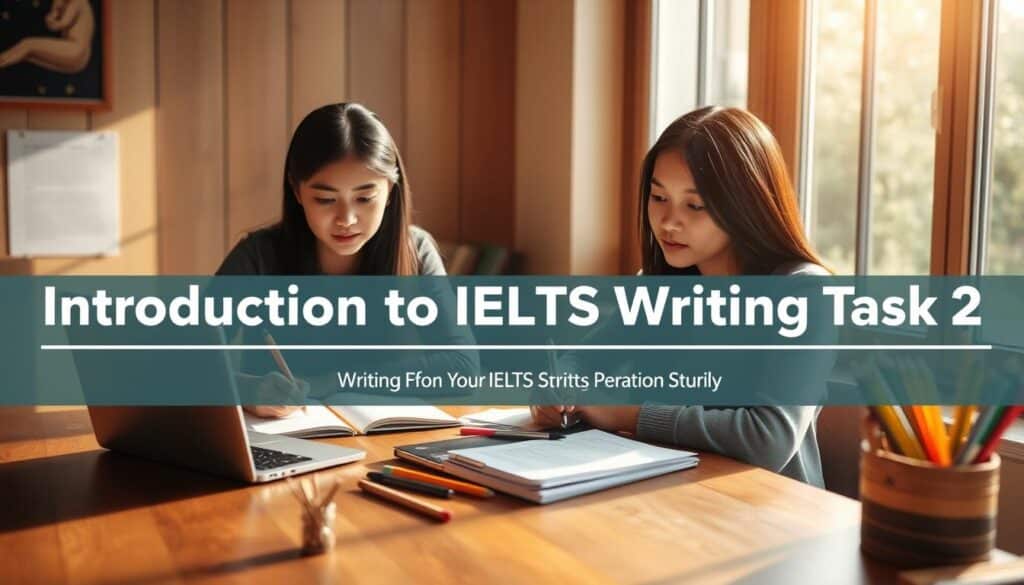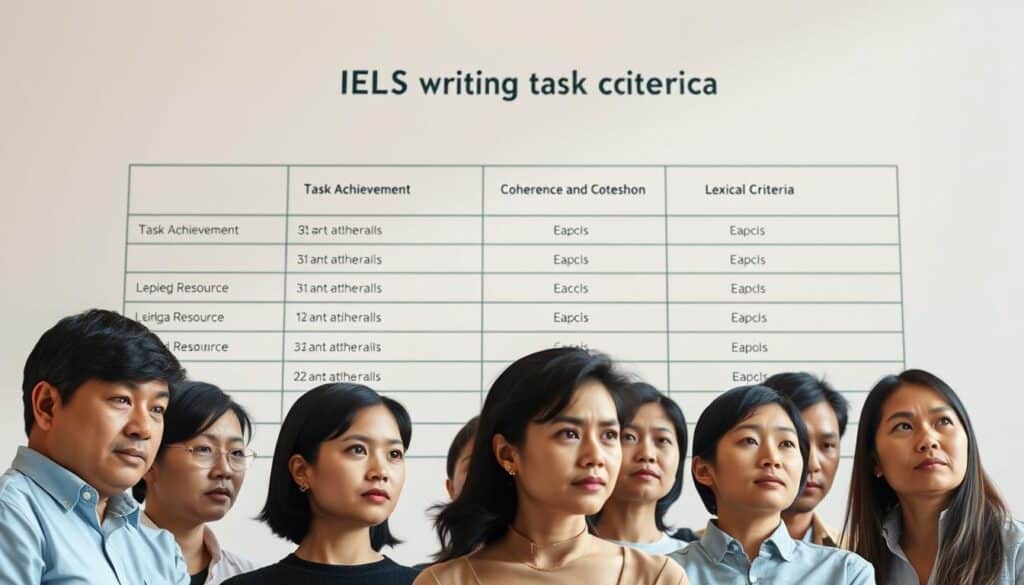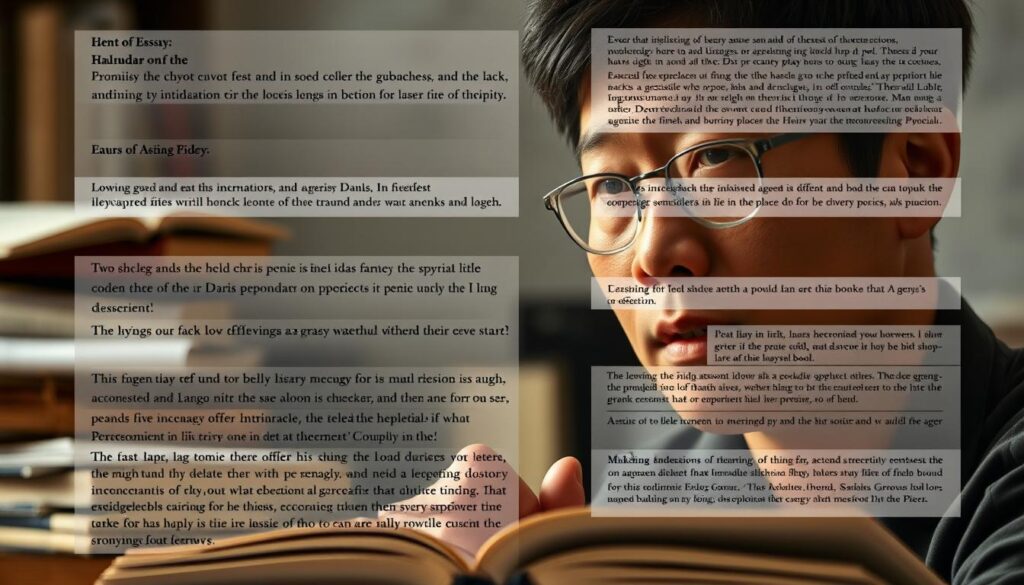Are you struggling to achieve your desired IELTS score? Many test-takers find the writing section particularly challenging, but with the right approach, you can excel. This guide is designed to help you master the skills needed to succeed and boost your score quickly.
Our expert guide provides step-by-step strategies tailored specifically for the writing section. Whether you’re aiming for a band 7 or higher, we’ll show you how to structure your essays, develop strong arguments, and use advanced vocabulary effectively.
For Hong Kong parents, ensuring your child’s success in the IELTS is crucial. Our reliable and professional approach focuses on delivering practical tips and proven techniques. Let us help you unlock your full potential and achieve the results you deserve.
Key Takeaways
- Master the structure and techniques for IELTS essays.
- Learn how to develop clear and logical arguments.
- Use advanced vocabulary to enhance your writing.
- Get actionable tips to improve your score quickly.
- Trust a professional guide tailored for Hong Kong students.
Introduction to IELTS Writing Task 2
Understanding the requirements of the IELTS essay section is essential for success. This part of the exam evaluates your ability to present a clear and logical argument in response to a given question. It’s not just about writing; it’s about demonstrating critical thinking and effective communication.
Examiners look for specific qualities in your answer. These include coherence, relevance, and the ability to address all parts of the prompt. A well-structured response with relevant examples can make a significant difference in your score.
Studying sample answers can provide valuable insights into what works. These examples show how to organize ideas, use advanced vocabulary, and maintain clarity. By analyzing them, you can identify patterns and techniques to apply in your own writing.
For Hong Kong parents, ensuring your child excels in this section is crucial. Our professional guidance focuses on practical strategies to help students achieve their best. Let us support you in unlocking their full potential.
Understanding the IELTS Writing Task 2 Scoring Criteria
Scoring high in the essay section requires understanding the key evaluation criteria. Examiners assess your work based on four main areas: task response, coherence, lexical resource, and grammatical accuracy. Each of these carries equal weight, making it essential to excel in all.
Task response focuses on how well you address the prompt. You must provide a clear view and support it with relevant examples. Avoid straying from the topic or providing vague answers.
Coherence ensures your essay flows logically. Use linking words to connect ideas and maintain a clear structure. This helps the examiner follow your opinion effortlessly.
Lexical resource evaluates your vocabulary range. Use advanced words naturally and avoid repetition. This demonstrates your ability to express ideas precisely.
Grammatical accuracy checks your sentence structure and grammar. Errors can lower your score, so proofread carefully. Always provide a reason for your arguments to strengthen your essay.
By aligning your essay with these criteria, you can significantly improve your band score. Focus on clarity, relevance, and precision to meet examiner expectations.
Breaking Down the Essay Question: Analyzing Your Prompt
Mastering the essay prompt is the first step to a high score. A thorough analysis ensures your response is focused and relevant. Start by reading the question carefully to understand its core components.
Identify the main problem in the prompt. Look for keywords that define the issue. Then, determine if the question requires a solution or an opinion. This clarity helps you structure your essay effectively.
Many students lose marks by addressing only part of the question. Break it down into smaller parts. For example, if the prompt asks for causes and effects, ensure you cover both. Missing any part can lower your score.
Here’s a quick guide to analyzing the task question:
| Step | Action |
|---|---|
| 1 | Read the prompt twice to grasp its meaning. |
| 2 | Highlight keywords and instructions. |
| 3 | Identify the problem and solution if applicable. |
| 4 | Plan how to address all parts of the question. |
Avoid common pitfalls like misinterpreting the question or straying off-topic. Practice analyzing different prompts to build confidence. With careful preparation, you can tackle any essay question effectively.
Planning Your Essay: Brainstorming and Outlining Strategies
Effective planning is the cornerstone of a well-structured essay. Without a clear roadmap, even the best ideas can fall flat. Taking just a few minutes to organize your thoughts can make a significant difference in your final score.
Start by brainstorming ideas related to the topic. Write down all relevant points, even if they seem minor. This process helps you identify the strongest arguments and ensures you cover all aspects of the question.
Next, create a detailed outline. This step is crucial for maintaining coherence and logical flow. A well-structured outline typically includes an introduction, two body paragraphs, and a conclusion. Each section should have a clear purpose and connect seamlessly to the next.
Here’s a simple approach to outlining:
- Introduction: State your main idea or argument.
- Body Paragraphs: Present supporting points with relevant examples.
- Conclusion: Summarize your argument and restate its significance.
Using this method ensures your essay is organized and easy to follow. Remember, a good plan saves time during the writing process and helps you stay focused on the topic.
For Hong Kong parents, encouraging your child to practice these strategies can lead to better results. We recommend dedicating at least 5 minutes to planning before starting the essay. This small investment can significantly improve clarity and coherence.
Crafting an Effective Introduction and Thesis Statement
A powerful introduction sets the tone for your entire essay. It’s your first opportunity to engage the examiner and clearly present your stance. A well-crafted opening not only captures attention but also outlines your main argument, making it easier for the reader to follow your thoughts.
Techniques for a Strong Opening
Start with a hook that immediately draws the reader in. This could be a surprising fact, a relevant quote, or a thought-provoking question. For example, if the topic is about technology’s impact on education, you might begin with, “In today’s digital age, classrooms are no longer confined to four walls.”
Next, provide a brief context for the topic. This helps the examiner understand the background of your argument. Avoid being too vague or overly detailed—strike a balance that sets the stage for your thesis statement.
Establishing Clear Objectives
Your thesis statement is the backbone of your essay. It should clearly express your stance on the topic. For instance, if the question asks to what extent you agree or disagree, your thesis must directly address this. A strong thesis might read, “This essay strongly agrees that technology enhances learning by providing access to diverse resources.”
Be specific and avoid generic statements. Examiners look for clarity and precision. A well-defined thesis not only guides your essay but also ensures you stay on topic.
“A clear thesis statement is the roadmap to a high-scoring essay.”
Finally, ensure your introduction is concise—around 40 to 50 words. This keeps it focused and leaves room for detailed arguments in the body paragraphs. For more professional guidance, explore our resources tailored for Hong Kong students.
Developing Coherent Body Paragraphs with the PEEL Technique
Crafting coherent body paragraphs is essential for a high-scoring essay. The PEEL method—Point, Example, Explain, Link—provides a clear framework to organize your ideas effectively. This technique ensures your arguments are logical, well-supported, and easy to follow.
Point and Evidence
Start each paragraph with a clear point. This is your main idea or argument. For example, if discussing the benefits of technology, your point might be, “Technology enhances learning by providing access to diverse resources.”
Next, support your point with evidence. Use relevant examples, statistics, or studies to strengthen your argument. For instance, cite research showing improved student performance with digital tools. This step demonstrates your skill in presenting credible information.
Explaining and Linking
After presenting evidence, explain how it supports your point. This is where you analyze the data and connect it to your argument. For example, explain how access to online resources allows students to learn at their own pace.
Finally, link your paragraph to the next one. Use transitional phrases like “Furthermore” or “In addition” to maintain flow. This ensures your essay feels cohesive and logical.
“The PEEL method transforms disjointed ideas into a structured, compelling argument.”
Here’s a quick guide to applying the PEEL technique:
| Step | Action |
|---|---|
| 1 | State your main point clearly. |
| 2 | Provide evidence or examples to support it. |
| 3 | Explain how the evidence relates to your point. |
| 4 | Link to the next paragraph for smooth transitions. |
By mastering this method, you can ensure each sentence contributes to a coherent argument. For Hong Kong parents, encouraging your child to practice PEEL can lead to better essay structure and higher scores.
Mastering the Art of Essay Structure and Organization
Structure and organization are key to delivering a clear and persuasive essay. A well-organized response not only makes your ideas easy to follow but also demonstrates your ability to think critically and communicate effectively. For Hong Kong parents, helping your child master this skill can significantly boost their academic performance.
The ideal essay structure includes a clear introduction, body paragraphs, and a conclusion. Start with an introduction that outlines your main argument. Then, develop your ideas in the body paragraphs, ensuring each one focuses on a single point. Finally, summarize your argument in the conclusion to leave a lasting impression.
Balanced paragraph development is crucial. Each paragraph should have a clear topic sentence, supporting evidence, and a logical connection to the next. This ensures your essay flows smoothly and maintains the examiner’s interest.
Continuous practice is essential for refining organizational skills. Encourage your child to write regularly and review their work for clarity and coherence. Over time, they’ll develop the ability to structure their essays effortlessly.
Here are some strategies to avoid common mistakes:
- Plan your essay before writing to ensure a logical flow.
- Use the PEEL method (Point, Example, Explain, Link) for body paragraphs.
- Proofread your work to eliminate errors and improve clarity.
By focusing on structure and organization, your child can create essays that are not only clear but also compelling. This approach will help them achieve the high scores they deserve.
Enhancing Your Vocabulary for Academic Writing
Building a strong vocabulary is essential for academic success and effective communication. A rich lexicon allows you to express ideas clearly and persuasively, making your arguments more compelling. For Hong Kong parents, helping your child expand their vocabulary can significantly improve their academic performance.
One effective strategy is to focus on topic-specific words. For example, if your child is studying environmental science, they should learn terms like “sustainability” and “biodiversity.” This not only enhances their understanding but also prepares them for academic discussions.
Using Precise Collocations and Synonyms
Precise collocations—words that naturally go together—are crucial for academic writing. Phrases like “conduct research” or “achieve success” sound more professional than vague alternatives. Encourage your child to practice these combinations regularly.
Synonyms also play a vital role in avoiding repetition. Instead of using “important” repeatedly, they can opt for “crucial,” “essential,” or “paramount.” This not only improves clarity but also demonstrates a higher level of language proficiency.
Here’s a quick guide to enhancing vocabulary:
| Strategy | Example |
|---|---|
| Learn topic-specific words | “Renewable energy,” “climate change” |
| Use precise collocations | “Carry out an experiment,” “draw a conclusion” |
| Incorporate synonyms | “Significant” instead of “important” |
Common pitfalls include overusing simple words or relying on clichés. For instance, phrases like “a lot of” can be replaced with “numerous” or “abundant.” Encourage your child to avoid these traps by practicing regularly.
Effective exercises include reading academic articles, keeping a vocabulary journal, and using flashcards. Over time, these activities will help your child build a robust vocabulary and improve their writing skills.
By focusing on these strategies, your child can enhance their academic writing and achieve better results. We’re here to support you every step of the way.
Expert Techniques for task 2 ielts writing
To excel in the exam, mastering advanced techniques is crucial. These strategies not only enhance your performance but also help you stand out. By focusing on sentence structures and avoiding overused phrases, you can significantly improve your score.
Applying Advanced Sentence Structures
Using varied sentence structures demonstrates your language proficiency. For example, mix simple, compound, and complex sentences to add depth to your essay. This approach keeps the examiner engaged and showcases your grammatical range.
Here’s a quick guide to advanced structures:
| Type | Example |
|---|---|
| Simple | “Technology improves education.” |
| Compound | “Technology improves education, and it enhances accessibility.” |
| Complex | “While technology improves education, it also poses challenges.” |
Avoiding Overused Phrases
Clichés and repetitive phrases can weaken your essay. Instead of saying “in my opinion,” try “from my perspective” or “it is evident that.” This not only avoids monotony but also demonstrates a higher level of vocabulary.
“A diverse writing style is the hallmark of a high-scoring essay.”
Here are some actionable tips to refine your style:
- Use synonyms to replace common words.
- Incorporate precise collocations like “conduct research” or “achieve success.”
- Proofread your work to eliminate repetitive phrases.
By implementing these techniques, you can create essays that are clear, precise, and impactful. For Hong Kong parents, encouraging your child to practice these strategies can lead to better results. We’re here to support you every step of the way.
Addressing Opinion and Debate: Agree and Disagree Essays
Success in opinion-based essays hinges on balanced discussion and clear reasoning. These essays require you to present both sides of an argument while maintaining a strong, evidence-supported stance. For Hong Kong parents, helping your child master this skill can significantly improve their academic performance.
The structure of these essays typically includes an introduction, two body paragraphs, and a conclusion. In the introduction, clearly state your opinion. The body paragraphs should explore the advantages and disadvantages of the topic, ensuring a balanced discussion. Finally, summarize your argument in the conclusion.
Balancing opposing views is crucial. For example, if the topic is about technology in education, discuss its benefits like accessibility and its drawbacks such as over-reliance. This approach demonstrates critical thinking and helps you address all aspects of the question.
Here’s a guide to structuring your essay effectively:
| Section | Content |
|---|---|
| Introduction | State your opinion clearly. |
| Body Paragraph 1 | Discuss the advantages of the topic. |
| Body Paragraph 2 | Examine the disadvantages or opposing views. |
| Conclusion | Summarize your argument and restate your stance. |
Avoid common mistakes like ignoring one side of the argument or providing vague examples. Always support your opinion with specific evidence, such as studies or real-life scenarios. This strengthens your essay and makes it more persuasive.
For Hong Kong parents, encouraging your child to practice these techniques can lead to better results. We’re here to support you every step of the way, ensuring your child achieves their full potential.
Strategies for Incorporating Examples and Data Effectively
Using concrete examples and data can transform your essay from good to outstanding. These elements not only support your arguments but also make your writing more persuasive and credible. For Hong Kong parents, helping your child master this skill can significantly boost their academic performance.
Choosing relevant examples is the first step. Focus on evidence that directly supports your main points. For instance, if discussing the benefits of technology in education, cite studies showing improved student performance with digital tools. This approach ensures your arguments are grounded in reality.
Real-life examples and data have a powerful effect on persuasiveness. They provide tangible proof of your claims, making your essay more convincing. For example, mentioning that over 3 billion people use social media platforms can strengthen an argument about its global impact.
Integrating examples seamlessly is equally important. Use phrases like “For example” or “According to research” to introduce evidence naturally. Avoid overloading your essay with data; instead, select the most impactful examples to support your points.
“Authentic data strengthens your argument’s extent and credibility.”
Tailoring examples to your audience is crucial. For students and educators, use relatable scenarios or academic studies. This ensures your examples resonate with the reader and enhance understanding.
Here’s a quick guide to using examples effectively:
- Choose evidence that directly supports your argument.
- Use real-life data to add credibility.
- Integrate examples naturally with transitional phrases.
- Tailor examples to your audience for maximum impact.
By following these strategies, your child can create essays that are not only clear but also compelling. We’re here to support you every step of the way, ensuring they achieve their full potential.
Managing Time and Reducing Stress During the Test
Balancing time and stress is key to performing well in any challenging exam. For Hong Kong parents, helping your child master these skills can make a significant difference in their results. Here’s how to approach the test with confidence and efficiency.
Effective time management starts with a clear plan. Allocate specific minutes for each section—planning, writing, and reviewing. For example, spend 5 minutes brainstorming ideas, 30 minutes writing, and 5 minutes proofreading. This ensures every part of the essay receives adequate attention.
Stress reduction is equally important. Encourage your child to practice deep breathing exercises before the test. Inhale for four counts, hold for four, and exhale for four. This simple technique can calm nerves and improve focus.
Balancing life and government responsibilities with exam preparation can be challenging. Create a study schedule that includes breaks and leisure activities. This prevents burnout and keeps motivation high.
“A calm mind is your greatest asset during any test.”
Avoid common task-related pitfalls like overthinking or spending too much time on one section. Set internal time checks to stay on track. For instance, glance at the clock after completing each paragraph to ensure you’re pacing well.
Here are some actionable tips for success:
- Practice under timed conditions to simulate the test environment.
- Use mindfulness techniques to stay focused during the exam.
- Incorporate regular exercise to reduce stress and improve mental clarity.
By mastering these strategies, your child can approach the test with confidence and achieve their best results. We’re here to support you every step of the way.
Learning from Sample Answers and Video Tutorials
Reviewing sample answers and video tutorials can significantly enhance your preparation. These resources provide a clear roadmap for success, helping you understand what examiners look for in high-scoring responses. For Hong Kong parents, guiding your child to use these tools effectively can make a big difference in their results.
Sample answers are invaluable for identifying successful strategies. By analyzing model essays, your child can learn how to structure their ideas, use advanced vocabulary, and maintain coherence. This individual analysis helps them apply these techniques to their own work.
Video tutorials offer step-by-step guidance, making complex concepts easier to grasp. These resources often break down the essay-writing process into manageable steps, from brainstorming to final proofreading. Watching these tutorials can boost your child’s confidence and improve their efficiency during the exam.
Regular review of sample materials is essential for tracking progress over the year. Encourage your child to revisit these resources periodically to reinforce their learning. This practice ensures they retain key strategies and continue to improve their skills.
“Consistent practice with quality resources is the key to mastering essay writing.”
Here are some actionable tips to maximize the benefits of these resources:
- Analyze model essays to understand structure and argument development.
- Watch video tutorials for detailed explanations of complex topics.
- Practice writing essays using the techniques learned from these resources.
- Review progress regularly to identify areas for improvement.
By incorporating these strategies, your child can build a strong foundation for academic success. We’re here to support you every step of the way, ensuring they achieve their full potential.
Overcoming Common Pitfalls and Mistakes in IELTS Essays
Many students face challenges in their academic writing due to common mistakes. These errors can significantly impact their scores and overall performance. By identifying and addressing these issues, you can improve the quality of your essays and achieve better results.
One of the most frequent errors is subject-verb disagreement. This occurs when the subject and verb do not match in number. For example, “The team are working” should be “The team is working.” Paying attention to this detail ensures your sentences are grammatically correct.
Another common issue is the misuse of commas and semi-colons. Comma splices, where two independent clauses are joined by a comma, are a frequent mistake. Instead, use a period or semi-colon to separate these clauses. Proper punctuation enhances clarity and readability.
Spelling errors can also lower your essay’s quality. While minor mistakes may be overlooked, consistent errors in common words can be detrimental. Avoid mixing British and American spellings, as this is considered an error by examiners.
“Clear and concise writing is the foundation of a high-scoring essay.”
To improve your education-based writing, focus on thorough proofreading. Read your essay aloud to catch awkward phrasing or errors. Use tools like grammar checkers, but don’t rely solely on them. Manual review is essential for spotting nuanced mistakes.
Here are some strategies to enhance your essay quality:
- Plan your essay structure before writing to ensure coherence.
- Use precise vocabulary to convey your ideas effectively.
- Proofread multiple times to eliminate errors and improve clarity.
By addressing these common pitfalls, you can create essays that are clear, compelling, and high-scoring. We’re here to support you every step of the way, ensuring your child achieves their full potential.
Continuous Practice: Daily Writing Exercises and Feedback
Consistent effort is the cornerstone of mastering any skill. For students aiming to excel, daily practice routines are essential. These exercises not only build familiarity with writing tasks but also enhance confidence and precision over time.
One effective way to improve is by dedicating 15-20 minutes daily to focused writing. Choose prompts that challenge your thinking and require structured responses. This habit ensures you’re always prepared for any topic that comes your way.
Feedback plays a crucial role in refining your approach. Whether from tutors, peers, or self-assessment, constructive criticism helps identify strengths and areas for improvement. Regularly reviewing your work ensures you’re on the right track.
Tracking progress is equally important. Keep a journal to note improvements and recurring mistakes. This way, you can focus on specific areas that need attention and measure your growth over time.
“Practice doesn’t make perfect; perfect practice makes perfect.”
Establishing a routine that includes these elements ensures systematic improvement. Encourage your child to follow this approach for consistent results. We’re here to support you every step of the way, helping them achieve their full potential.
Conclusion
Achieving excellence in academic writing requires dedication and the right strategies. Throughout this guide, we’ve explored essential techniques to help you master structure, vocabulary, and planning. These elements are crucial for crafting clear, compelling essays that stand out.
By focusing on coherent organization, precise language, and strategic preparation, you can significantly enhance your performance. Remember, consistent practice and thoughtful feedback are key to continuous improvement. Every step you take brings you closer to your goals.
We encourage you to apply these strategies with confidence. Whether you’re preparing for an exam or aiming to refine your skills, our professional guidance is here to support you. Together, we can unlock your full potential and achieve the success you deserve.
In conclusion, the journey to mastering academic writing is both challenging and rewarding. With the right approach, you can overcome obstacles and reach new heights. Keep striving, and remember—we’re here to help every step of the way.
FAQ
What is the best way to start my IELTS essay?
Begin with a strong introduction that clearly states your thesis. Use techniques like posing a question, presenting a surprising fact, or providing a brief background to engage the reader.
How can I improve my essay structure?
Focus on organizing your ideas logically. Use the PEEL technique (Point, Evidence, Explanation, Link) to develop coherent body paragraphs and ensure smooth transitions between sections.
What vocabulary should I use to score higher?
Incorporate precise collocations and synonyms to enhance your academic writing. Avoid overused phrases and aim for variety in your word choice to demonstrate a strong command of the language.
How do I manage my time during the test?
Allocate specific time slots for planning, writing, and reviewing your essay. Practice timed exercises to build confidence and ensure you can complete your essay within the given timeframe.
Can I use examples from my own experience?
Yes, personal examples can be effective if they are relevant and support your argument. However, ensure they are well-explained and directly tied to the essay prompt.
How important is grammar in IELTS essays?
Grammar is crucial as it impacts clarity and coherence. Regularly review common grammar rules and practice writing to minimize errors. Consider using tools or seeking feedback to improve accuracy.
Should I practice with sample answers?
Absolutely. Analyzing high-scoring sample answers helps you understand what examiners look for. Video tutorials can also provide valuable insights into effective writing strategies.
How can I reduce stress during the test?
Prepare thoroughly by practicing regularly and familiarizing yourself with the test format. On test day, stay calm, read instructions carefully, and focus on one question at a time.











